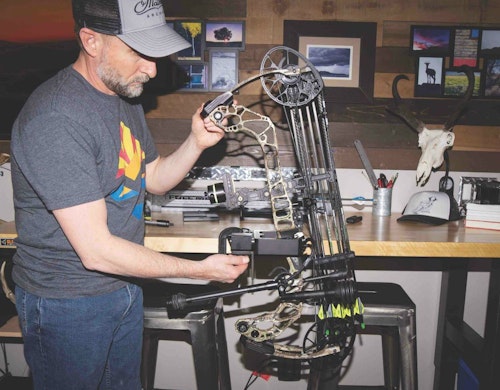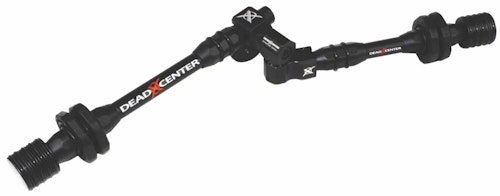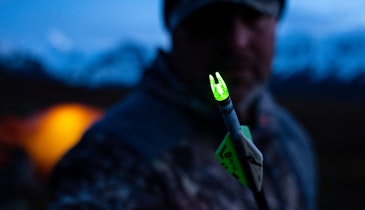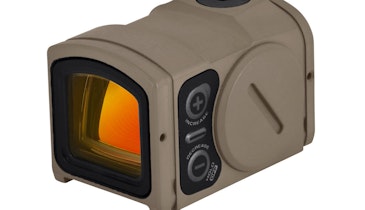I first saw the Dead Center Pro Bow Balancer at the 2018 ATA Show. In fact, it was one of the most talked about products that year. Oddly enough, this product is not one you are likely to stock in your store for consumers to purchase. Rather, the Pro Bow Balancer provides a new revenue stream from the increase in sales of stabilizers and their mounting accessories.
Since that first exposure to bow balancing, I have kept my ear to the ground with regard to the bow-balancing business by talking with several pro shop owners periodically. It’s true, having a tool for bow balancing has not hit the mainstream at this point. However, it is gaining momentum. Of course, bow balancing is firmly planted within the target archery community; however, hunters have taken note of the pros of bow balancing and its effect on accuracy. Most notably, the pros are using proper weight distribution to improve aiming, as well as lessening biased movement during recoil.
The good news: There is definitely room for an expansion of the hunting stabilizer market for the willing pro shop to invest in. A first step may be to consider the Dead Center Pro Balancer as an addition to your pro shop services. Recently, I had the opportunity to chat in-depth with Dead Center’s resident technical expert, Jim Ream to get his takeaway on the bow-balancing market. Here are his impressions.
DC: Tell us about the history of Dead Center Archery.
JR: Todd Reich, owner of Dead Center Archery Products, started the company in 2007 with a basic aluminum target and hunting series stabilizers.
DC: When was the Dead Center Pro Bow Balancer released?
JR: Todd invented the Pro Bow Balancer in 2010 purely out of necessity. Todd recognized that there was no precise way of installing stabilizers and weights on a bow with any measure as to their affect. Any current method was simply guess work. Todd wanted a way to see exactly what every stabilizer, weight and configuration was doing to the bow to have a true neutral starting point and for effective fine tuning to help archers achieve optimum performance.
Over the years, the Pro Bow Balancer has made it into the hands of avid archers, pro archers, pro shops and archery coaches around the world. Users of the Pro Bow Balancer find it invaluable when setting up and tuning their stabilizer configurations. In December of 2018, Dead Center Archery Products was awarded a U.S. Patent for the innovative Pro Bow Balancer tool.
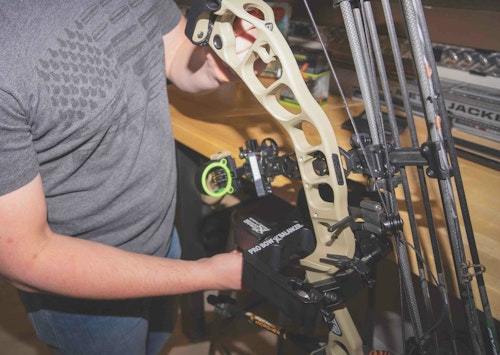
DC: Was the Pro Bow Balancer developed for target archers, bowhunters or both?
JR: The Balancer was developed mainly for target archery. This allows the archer a starting point to perfect balance. We all know everyone’s form is a little different so the weight configuration might need to be changed depending on feel of the shot execution. We later found out the dead level kit was able to be balanced in the Pro Bow Balancer as well. Giving hunters better down range accuracy at longer distances. This gave the bow a target feel with a hunter setup.
DC: What tips do you have for archery retailers adding a bow balancer to their pro shop? Any tips on increasing revenue with it?
JR: If pro shops would add a Pro Bow Balancer to their shop services, the main thing I would recommend is to keep the Balancer visible to the public with a balanced bow in it. And when there are customers in the store make it a point to walk by the Balancer and bump the bow so it will move and rotate so the customer will get curious and ask some questions about it. They will then want their bow balanced.
Shops will sell more brackets and weights by having a Pro Bow Balancer.
DC: Please provide a few bow-balancing basics.
JR: As far as balancing basics, you absolutely need a back bar. You cannot balance a bow without one. Even though some customers think you can but it’s impossible. A good rule of thumb for a target set up is whatever you run on the front as far as stabilizers run at least half of that on the back. For example if you run a 28-inch front bar, you want to run a 12-inch back bar. For weights it’s about a one to three ratio if you run 3 ounces on the front, you will run around 9 ounces on the back.
For a hunting setup, this is where it gets a little tricky and this balancing act depends a lot on the bow you are shooting — ATA, riser length, grip location, if the shooter is worried about mass weight, etc. — since the bars will normally be under 10 inches. On my hunting setup I like to run a 10-inch with 1 to 2 ounces in the front and 8-inch in the back with 6 to 8 ounces of weight. This seems to work the best for me.
DC: How do sights and quivers affect bow balance?
JR: Sights and quivers are very important when it comes to bow balance. Let’s start with the quiver; I recommend taking it off to balance your bow. Shoot the bow in and when you get to your spot to hunt, don’t hunt with your quiver on. I know you’re probably thinking arrows don’t weigh that much, 400 to 500 grains. But every little bit of weight matters in your balance. And every time you remove an arrow from that quiver it changes the whole system. So you’re better off not using it. Just use it to get your arrows in and out of the field. Your sight is another story, you need that. The heavier the sight, the more of an angle to the left, for a right handed shooter, you will need to adjust your back bar. This adjustment will be done with your back bar bracket. I recommend the Diamond Series Single Offset Mount or the Combo Mount.
DC: Is there a major difference balancing a longer axle-to-axle bow compared to a shorter one?
JR: Yes there is a difference between balancing a longer ATA bow than a shorter ATA bow. The longer bow will be easier to balance. Especially with shorter hunting style stabilizers.
DC: In your opinion, what stabilizer system(s) work best for balancing?
JR: Target bars work best for balancing because of the length. They just make it easier to work with.
DC: What are the basic tools needed for bow-balancing work?
JR: The only tools you need to balance a bow is a set of Allen wrenches. That is to tighten the brackets and weights down when you are done.
DC: How long does it take to become a proficient bow balancer?
JR: I say once you’ve balanced four to five bows of each brand. At that point, you know what they’re like, what to look for and you should be proficient at it.
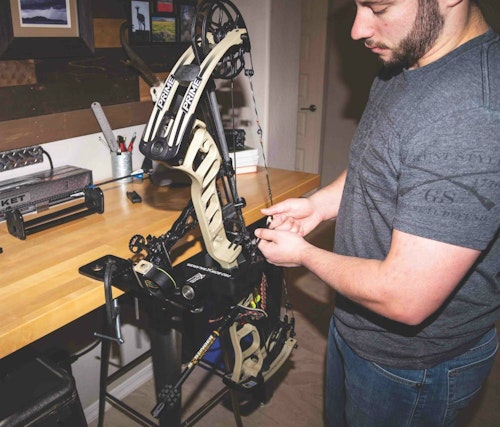
More About the Dead Center Pro Bow Balancer
The Pro Bow Balancer from Dead Center Archery Products is a revolutionary tool to take the guess work out of stabilizer and weight configuration, which in turn eliminates the notion of “close enough.” World renowned archery coaches, professional archers, pro shops and avid archers worldwide choose the Pro Bow Balancer because precision balance does matter.
The Pro Bow Balancer allows the user to identify a bow’s balance point or balance bias so that effective changes can be made without crude guess work or trial-and-error methods. The tool utilizes a universal cradle that attaches to the bow at the grip area, allowing both front-to-back and left-to-right movement in free-floating fashion. Once weighted stabilizers and weights are mounted, the finished product is a perfectly balanced bow.
Benefits
- Precise Balance. Add weight. Just a 1⁄5 ounce of weight or 1⁄16-inches of movement in a stabilizer mount changes everything.
- Effective Fine Tuning. Fine tune the position of your stabilizers and weights to suit the specific and individual balance needs of any shooter.
- Optimum Aiming Stability. Proper balance will provide each individual shooter an optimal aiming experience for better shot execution.
- Increased Moment of Inertia. Ensures the stabilizers do the job they were intended to do.
- Optimized Accuracy. Proper, customized balance to increase accuracy.
Sidebar: Budget Balancing, Service Building
The challenges of shooting a bow are numerous and can be overwhelming for many archers. Modern archers, especially bowhunters, are looking for every advantage to make them more accurate on the range and in the field. The Pro Balancer provides a first-hand, visual representation to utilize while educating customers about the relationship between bow weight and balance with proper shot execution, and therefore accuracy. While doing so, you can put a few extra bucks in your bank account.
Chris DiPerna, owner of Creek Archery in Pennsylvania, estimates that his pro shop balances five bows per week with an average sale of $200. Billy Gibson, owner of Broken Rack Archery in Ohio, see similar numbers in his shop. When you do the math, the total is fairly large even if you estimate it conservatively. The most popular overall stabilizer kit is one from Dead Center, the “Hunter Kit.”
Dead Center Dead Level Hunter V2 Stabilizer Kit (8 inches and 6 inches) includes:
- One pair of 6-inch and one 8-inch V2 stabilizers
- Six 1-ounce weights
- Two aluminum cap weights
- Diamond series combo mount
- MSRP: $199.99
Of course, money isn’t the end all. Although a purchase occurs, both shop owners take pride in helping their local target archers and bowhunters become more proficient and ultimately successful in their endeavors. “Those that are serious about their craft are willing to spend the necessary dollar amount to have it set up correctly,” DiPerna stated. “Some shooters are unaware that conditions like target panic can actually be remedied with a properly balanced bow,” Gibson added. The takeaway: Selling more product while providing the utmost in customer service is a definite win-win.
Sidebar: Target Stabilizers
Dead Center Dead Steady Target Starter Pack (24 inch/10 inch)
Offers competitive target archers a complete kit with everything needed to precision balance and tune your target set up. The kit includes competition proven Dead Steady Stabilizers, rock solid Diamond Series hardware and customizable 1-ounce weights.
Featured Technology
- Dead Steady target stabilizers offer the proven performance and stability that competitive target archers demand
- 3⁄4-inch diameter pultruded carbon construction provides rigidity without added weight
- Diamond Series hardware is precision engineered to offer infinite adjustability, rock solid performance and perfect balance
- Custom balance weights allow for the custom tailoring of the weight configuration for precision balance and tuning for an optimum aiming experience and increased accuracy
Kit Includes:
- Two Dead Steady Target Stabilizers: 24 inch, 6.6 ounces and 10 inch, 4.2 ounces
- One Diamond Series Combo Mount
- Six 1-ounce Custom Balance Weights - 1/4-20 threaded
- MSRP: $279.99
Contact: www.deadcenterarchery.com
Balanced Hunting Stabilizer: Bee Stinger Microhex Counter Slide
Achieving perfect balance and offsetting the weight of your sight, quiver, and other accessories has never been more accurate, adaptable, or simple. The Microhex Counter Slide with dovetail mount offers limitless configurations for you to customize the optimal balance for you — whether you’re hunting or target shooting. Microhex with exclusive Countervail Technology delivers 40 percent less vibration.


